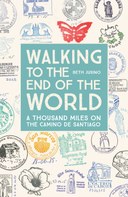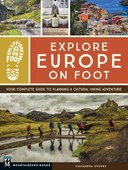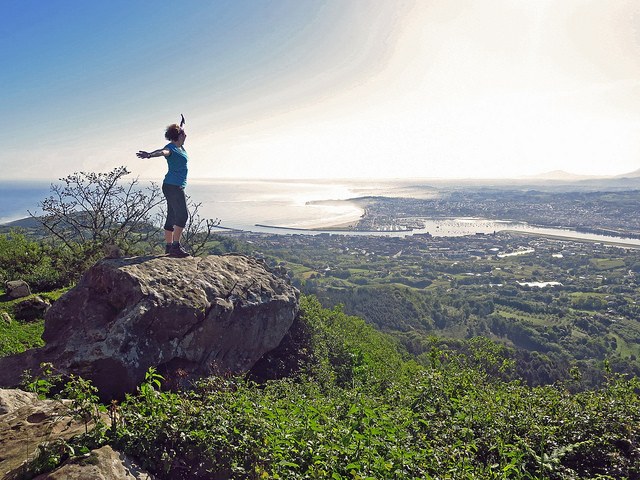
The following is excerpted from Walking to the End of the World: A Thousand Miles on the Camino De Santiago, Beth Jusino.
INTRODUCTION: THE TRAIN
I climbed the narrow stairs to the upper level of the train, my backpack strapped over my shoulders, a bag of sandwiches clutched in my hand, and my husband a few steps behind me. The car was empty as I settled into a forward-facing seat, feeling smug. Everything was going exactly as planned.
Eric and I had flown from Seattle to Paris the day before, breezing through a predawn customs interview during a layover in Iceland. We easily found the high-speed train that took our jetlagged bodies directly from Charles de Gaulle Airport to Lyon, bypassing the confusion of downtown Paris. Following a map I’d printed at home, we navigated a few blocks to our Airbnb room in a private apartment, chatted with our English-speaking host, and found an open restaurant for dinner even though it was a holiday. (I didn’t know that the Monday after Easter is considered a holiday in France—but then, as far as I can tell, so are most Mondays and quite a few Tuesdays.)
The next morning Eric and I wandered through Lyon’s famous Les Halles market and indulged in our first cafés and pain au chocolat. We strolled along the Rhone River and were back at the station with an hour to spare before our local train departed for the two-hour ride southwest to Le Puy. So far, so good.
The monitors said that the train was on time, so I gathered my courage and stood in a food stand line to acquire, through pointing and a helpless look, jambon and Brie sandwiches for the road.
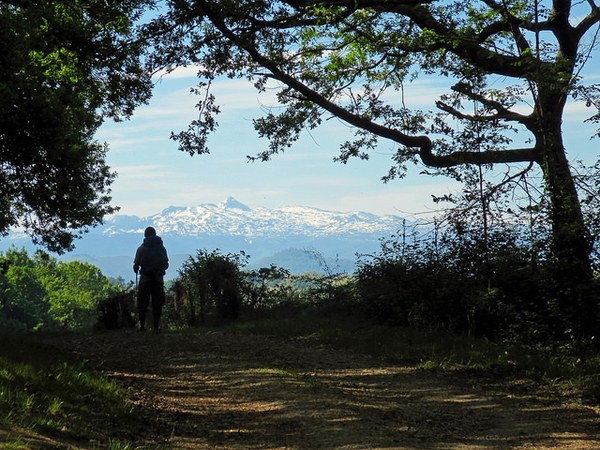
When the train doors opened, we were on the platform and ready to board. A man climbed into the train car right behind us. He was tall, almost gaunt, all angles and with what Eric would later describe as an epic French nose. He, too, was carrying a backpack. Eyeing our practical shoes and bulging packs, the man rattled off a string of syllables that sounded like a question.
My stomach tightened, and I responded with the sentence I’d practiced all morning: Je ne parle pas français (I do not speak French).
After months of sporadic online lessons, the only other sentence I felt confident with was Le pomme est rouge (The apple is red). If I thought carefully about the way to add a direct object, I could say, “The cat eats the apple.” Not once in the six weeks we spent in France did anyone ask me about apples.
Eric, though naturally better than me at linguistics, hadn’t bothered with any language lessons. He wanted to “learn French from the French,” which so far meant his vocabulary was limited to what he’d picked up watching a few French movies with English subtitles.
Undeterred, our train companion pointed to our bags. “Chemin de San Jacques?”
Oui! We were here to walk the Way of Saint James.
He nodded and pointed to himself. “Jean Claude.”
Well, of course he was. How very French.
Jean Claude, it turned out, knew a little Spanish, as did Eric. They pieced together that he was coming from Strasbourg, in northern France, to walk the Way. We told him we were Americans, from Seattle. That exhausted our vocabularies.
We were smiling mutely at one another, fellow travelers at the beginning of a great adventure, when a woman with a lit cigarette clattered up the metal stairs to our car, trailing smoke and perfume. She said something fast and loud. She looked angry, or maybe concerned. I let the words flow over me, distracted by the cigarette. Could she have that on a train?
Jean Claude, however, was suddenly all attention. He asked her something. She answered, gesturing out the window. He leapt to his feet and paused just long enough to find the words for us.
“Wrong train!”
There wasn’t time to ask questions, even if I knew how. The train to Le Puy left at 11:10. It was 11:05.
We scrambled to collect backpacks, jackets, and the bag of sandwiches, then tumbled out the doors and onto the platform, sprinting for the stairs. We dodged French families, workers, and whoever else stood around a train station in the middle of the day.
I found a screen. The Le Puy train now said Track F. The monitors had originally sent us to Track B, but must have changed as soon as we were out of sight. It was 11:07.
The three of us ran across the station, up a different set of stairs, and onto another platform. The train was still there.
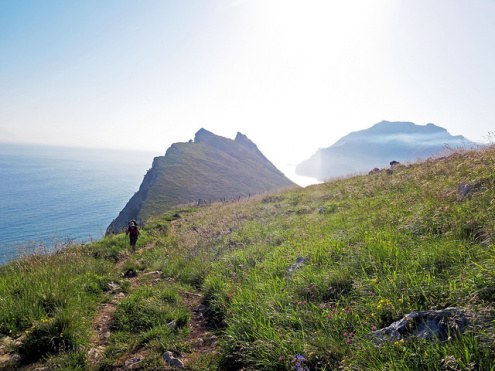
We dove through the first open door, into a car crowded with people. I saw backpacks, walking sticks, and solemn faces. The doors slid closed while we were still standing, panting, and the train started moving before we could sit down.
The train we’d first boarded went the opposite direction that day, to the industrial city of Grenoble. Twelve weeks later, when we were resting a thousand miles away on the Atlantic Coast, a man in Grenoble would behead his former boss, throw explosive gas canisters at a chemical factory, and raise an Islamic flag. France, already on edge after the Charlie Hebdo attacks, would raise the terror threat level to high.
But on that Tuesday, Eric and I were going back in time, not forward. We were bound for a thousand-year-old story full of Knights Templar and saints performing miracles.
As the train cleared the station, we collapsed into the last seats available, near the bathroom and facing backward. I get sick on moving vehicles, especially if I’m facing backward. But at least we were going to the right place. And after this, we’d be on foot. Surely it would be easier on foot.
Or maybe not. The pattern of those confusing ten minutes in the train station, I learned, would repeat itself over the next three months. I was sure that four years of reading every book, researching every item we carried, and soaking in the details of the Camino de Santiago, the Way of Saint James, would make me feel prepared. (I really like being prepared.)
But then, practically every day, the Camino threw me something unexpected. The train platform switch. The cow on the wrong side of the fence. The castle on the hill. The miracle sheep. The entire town that was “closed for rest.” The missing woman. The river perfect for swimming. And the people . . . the many, many people.
Somewhere I read that each person who walks the Camino de Santiago experiences it in three stages. Regardless of how far they go, what shape they’re in, or why they think they’re there, the first third of their journey will be a test of the body, the second a test of the mind, and the final third a gift to the soul.
Seventy-nine days gave us a lot of time for tests and gifts.
When we got home, people would ask, “How was your trip?” How does a person answer that? It was beautiful. Painful. Perspective changing. It taught me that there are some things I just can’t prepare myself for.
The only way to really explain it is to share it. So here we go.
Add a comment
Log in to add comments.I've been thinking about doing Sarria to Santiago in 2020, so I just bought Beth's book.
 Mountaineers Books
Mountaineers Books
